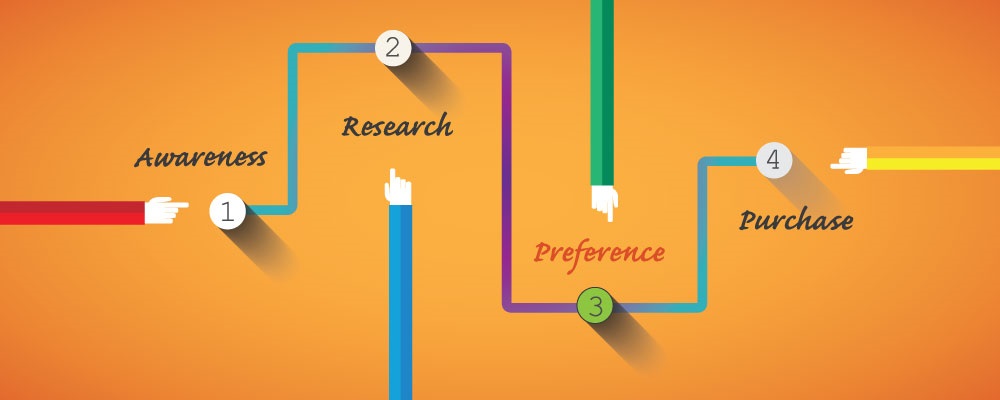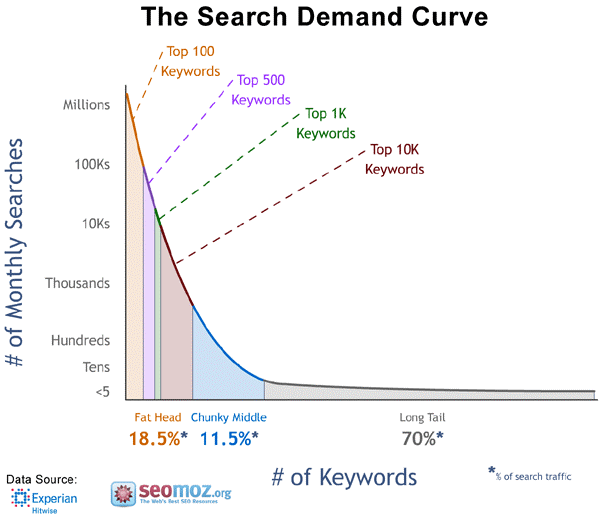By: Jacob Robinson
Increasing Conversion Rates With Long-Tail Keywords
A key metric to any business’s online performance is website conversion rate (the percentage of people who come to your website take some sort of action). There are various ways to increase conversion rates but one fundamental way to convert a higher percentage of people, is to get the “right” people to come to your site. One way we get the “right” people to a website is through long-tail keywords.
Driving the “Right” People to Your Website
Before we dive into long-tail keywords let’s define who the “right” person is, and how that person fits into the consumer buying process. The “right” person is a consumer who is ready to take some sort of action in regards to your general product or service (Ex. purchase a piece of jewelry or drive to a restaurant). If they are ready to take action when they arrive to your website, you will have higher conversion rates.

The Consumer Buying Process
The consumer buying process consists of the following stages: Awareness, Research, Preference/Intent, and Purchase. As we talk about long-tail keywords we will be operating within the Preference/Intent area of the buying process. In this area of the consumer buying process, we are aware of a problem (Awareness), we’ve done some research on a solution (Research), and we are now ready to decide how we will solve our problem.
Here’s an example of the consumer buying process:
- Awareness: You notice a strange smell coming from your car.
- Research: You ask your parents, perform some Google searches, and determine that you need to potentially have your transmission repaired. You also find in your research that there is a difference between repairing automatic and manual transmissions.
- Preference: You search online for “manual transmission repair and service”, to decide where you want to take your car for the repair.
- Purchase: After determining which auto shop in your town is best qualified to repair and service your transmission, you go there to purchase the service.
Now that we know the type of person we want to drive to our website, we can talk about long-tail keywords, and how they can effectively drive more website traffic, from people who are in this particular stage of the buying process.
The Definition of Long-Tail Keywords?
Simply put, long-tail keywords are keyword phrases that consist of 3 or more words. They are more specific and are used by consumers closer to the point of purchase (like we talked about above). Below are some examples of short tail vs long-tail keywords:
- Divorce Lawyer vs. High Net Worth Divorce Lawyer
- Plumber vs. Affordable Plumbing Services
- Car Repair vs. Transmission Leak Repair
As you can see, short tail keywords are just that, short. They are also very general. On the other hand the long-tail keywords are more specific.
Why Focus on Long-Tail Keywords?
Long-tail keywords can be considered low-hanging SEO fruit for many businesses. They are an easy way to drive traffic, increase conversion rate, and grow your bottom line. Let’s explore the various reasons we want to focus on long-tail keywords as part of our overall SEO strategy.
- Less Competition: The competitive landscape of long-tail keywords is not as fierce as that of short tail keywords. This makes it easier to rank organically for these terms.
- Semantic Search: Have you used Siri, Google Now, or Cortana on your phone to search for a service? If you have, you used semantic search. This means you searched like you would talk. Consumers are now searching semantically, which means its easier to rank for phrases (long-tail keywords) like “where can I get my oil changed?”. This search will yield different results than “oil change”.
- 70% of Queries are Long-Tail: Tweet This! Intuitively, you may think that focusing on generic keywords will drive more traffic (and they do receive a higher # of monthly searches), but solely focusing on generic keywords means you are losing out on a majority of relevant (and higher converting) search terms. It’s true, 70% of all the searches performed are long-tail keywords. The top keywords drive more search traffic, that’s for sure, but in their entirety they only account for only 30% of search! You can actually drive more traffic to your website through long-tail keywords.

- Target a Niche: Long-tail keywords allow you to target specific niches within your industry. Let’s call this micro-long-tail keywords. Look at this progression of keyword phrases: “Vietnamese Food” (short tail), “Vietnamese Restaurant Menu” (long-tail), “Traditional Banh Mi Vietnamese Restaurant” (micro-long-tail). Banh Mi is a specific type of sandwich that some Vietnamese restaurants carry. It is a niche that a Vietnamese restaurant could exploit in their SEO strategy.
- Conversion: As we discussed previously the main reason we want to target long-tail keywords in our SEO strategy is that we want to drive the “right” consumers to our website, in hopes that they make a purchasing decision.
Long-Tail Keywords: The Key to a Higher Conversion Rate
Understanding long-tail keywords will give you a new perspective on how you can effectively implement your SEO strategy. If done properly, targeting long-tailed keywords will drive more traffic to your website and will increase your conversion rate.
In the end isn’t that what we want? We want consumers to come to our site and we want them make a decision to purchase our product or service.
Next time you feel discouraged because you’re not ranking on page one for your generic industry or professional key terms, talk to your SEO about a long-tail keyword strategy! At Townsquare Interactive we utilize long-tail keywords as part of our overall SEO strategy. Interest in growing your web presence? Find out how Townsquare Interactive can help!
.png)